Sanatan Articles
Satyaagrah
Written on
Satyaagrah
Written on
Satyaagrah
Written on
Satyaagrah
Written on
Satyaagrah
Written on
JOIN SATYAAGRAH SOCIAL MEDIA
Story of Satyavani, one Underground Magazine that thrived during emergency 1975: Censorship imposed was selective and harsh, newspapers like TOI and HT were left alone while others bore a heavier brunt

Remember, remember not the Fifth of November but our own gunpowder, treason and plot. We see of no reason why this censored out season should ever be forgot.
[25th June marks the 40th Anniversary of Indira Gandhi’s declaration of an internal Emergency. What happened at Turkman Gate? How many countless lives were lost and destroyed by forced sterilisation? Who ultimately was the figurehead running India then? The deeply censored and scarcely talked about the event has been clouded under a veil - until now.]
“Many newspapers were printing wrong news to incite and mislead the people. Our purpose right now is to ensure that the current situation is one of peace and stability. This is the meaning of censorship.”
- Indira Gandhi’s All India Radio Broadcast informing the public about the proclamation of the Emergency.
The 40 years that have passed since the declaration of this statement play no role in diminishing its value. After having documented censorship in India over the last couple of months, the message issued by Mrs. Gandhi finds agreement in the core philosophy adopted by our political leaders in recent times.
While the common man may easily lament the incomplete democracy India harbours with a curtailed sense of freedom of speech and expression, our fourth estate had always enjoyed extensive freedom in its coverage and reportage of varying issues and opinions. This all changed under the second term of Indira Gandhi in 1971. But first, a little history of the press in this dark yet riveting period.
Media censorship at its most blatant
The Indira government, which had ushered into power with a thumping majority in 1971, saw itself quickly losing favour with the general public and press. The frustration was clearly evident when days before the declaration of the Emergency, Sanjay Gandhi confronted IK Gujral, the Information and Broadcasting Minister, on why his mother’s Boat Club Rally was not shown live on television.
The Minister, who was summoned to meet the Prime Minister was instead asked to meet her son who was displeased with his style of functioning. Sanjay also asked Gujral why the Hindi broadcast of All India Radio had read out Supreme Court’s stay on Indira Gandhi’s conviction verbatim and without any positive spin. “You don’t seem to know how to control your ministry. Can’t you tell them even how to put out the news?”
Sanjay Gandhi yelled at Gujral who received an equally furious response from the Prime Minister the next day. She told Gujral that she wanted to see the radio and TV scripts of all news bulletins before they went up, something she achieved completely with the Emergency.
 Saam Daam Dand Bhed: Sanjay Gandhi |
Sanjay Gandhi had instructed the Lt. Governor of Delhi to instruct BN Malhotra, the general manager of DESU to cut off the power for press offices located on the Bahadur Shah Zafar Marg but forgot the presses of Hindustan Times and The Statesman in Connaught Place, a fault which was attributed to Gujral. The ‘soft’ IK Gujral was deemed unfit to control the media as the complicit VC Shukla was made his successor in a haphazard manner as the Emergency was declared.
The anti-press mood in the government was set so high that Mohammad Yunus, a close friend of the Gandhis, called up Gujral on June 26th complaining about a BBC report which said that few in the government weren’t happy with the Emergency and were placed under house arrest.
Yunus wanted Sir Mark Tully, BBC’s Delhi Correspondent placed under arrest and provided advice on how to deal with him- “Pull down his pants and give him a few lashes and put him in jail”. A high-level government meeting that night decided that a law should be passed to prevent ‘scurrilous’ and ‘malicious’ writings in newspapers and journals with news agencies being restructured and Press Council Of India be wound up.
Media censorship at its most bizarre
The Emergency ushered in a bizarre era where statements like “Porn? Theek hai! Politics no” didn’t raise any eyebrows or disapproval. Khushwant Singh, then editor of The Illustrated Weekly, supported the Emergency but was equally displeased with the press censorship imposed, pleading with Indira Gandhi personally to repeal the Emergency only to receive “There cannot be any Emergency without censorship on the press” as a reply.
The censorship imposed was selective and harsh where newspapers like Times Of India and Hindustan Times were left alone while others bore a heavier brunt. Girilal Jain, the resident editor of Times Of India in Delhi praised the emergence of Sanjay Gandhi as newspapers not only gave into the censorship diktats and guidelines but would avoid news stories which might displease those in power, making LK Advani famously comment-”you were asked to bend, but you crawled.”
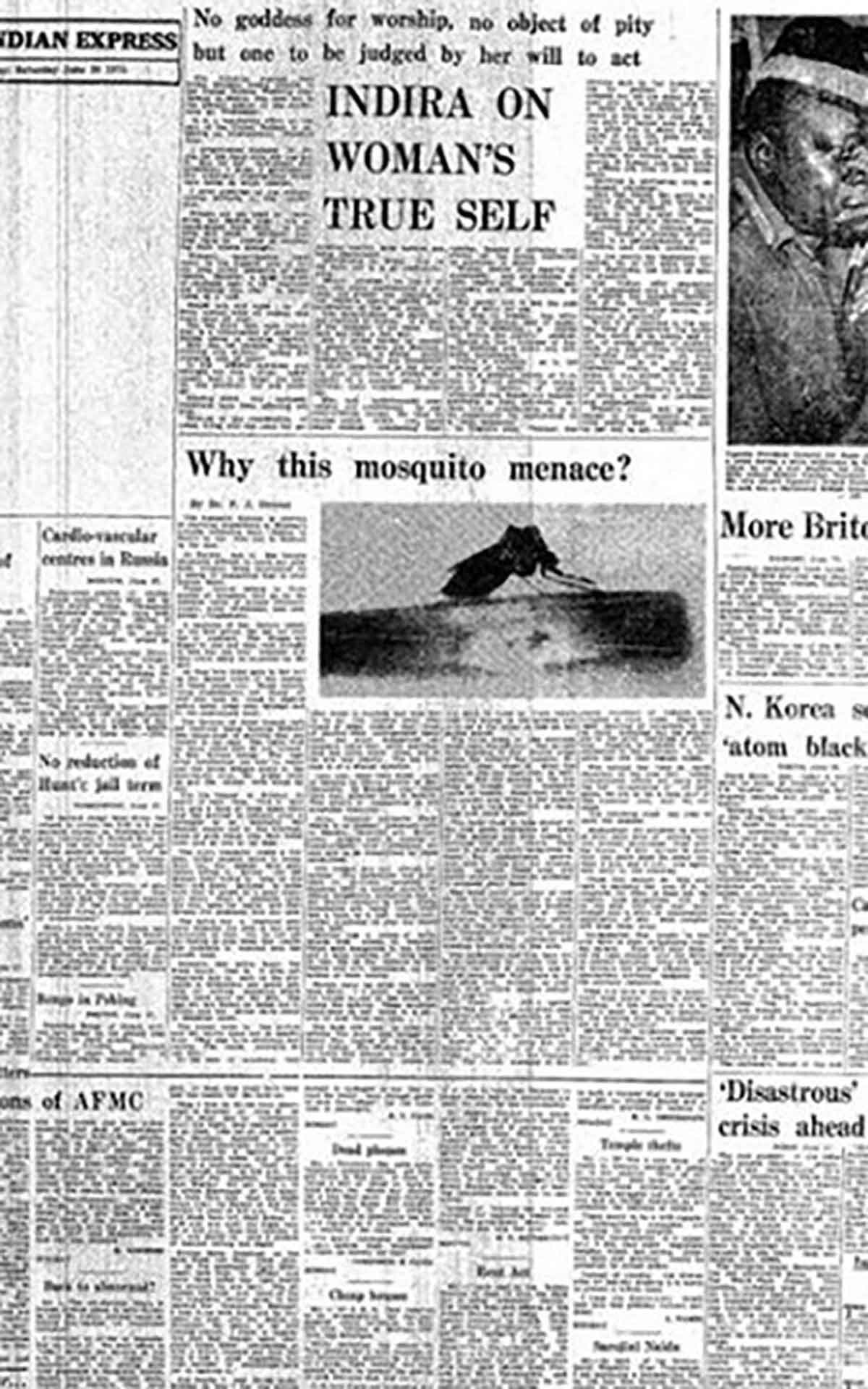 India, Indira Gandhi, Emergency 1975 |
The atmosphere of sycophancy and fear was occasionally disrupted by the Indian Express and Statesman who would manage to insert critical news pieces. The blank editorial carried by Indian Express on 28th June saw an order being passed, which gagged blank editorials from being published and the Supreme Court ruling in the Habeas Corpus case was heavily criticized by the Express.
But the few examples of defiance didn’t see any uniform reportage on daily life and jailed activists by the mainstream, which propelled those in the underground to create alternative sources of Information. And so we come to the riveting story of Satyavani.
The birth of underground media
Mahesh Mehta, a keen follower of the RSS from its early days in 1947, was instrumental in the growth of the VHP in its heydays in the United States. The largely apolitical work done by Mehta changed with the imposition of the Emergency in 1975. Mahesh found himself quickly drawn into politics as he hosted various underground leaders such as Atal Bihari Vajpayee, Kidarnath Sahani, and Makarand Desai. But the most significant achievement came in the form of the launch of Satyavani: Defenders of the Truth by the group including Dr. Subramaniam Swamy
‘Smugglers Of Truth’, a book by BJP leader Makarand Desai, contains selective articles and drawings from Satyavani as he charts out the early history and origins of the monthly magazine. The Janata Morcha victory in Gujarat acted like a temporary haven where Desai’s house acted as a meeting ground for various underground leaders such as George Fernandes and Subramaniam Swamy.
The group decided that there should be an international arm for the struggle for democracy in India. Makarand Desai and Subramaniam Swamy were smuggled abroad, with one set to act as the organiser and the other, the spokesman. This saw the creation of the Friends Of India Society International and a conference organised by the society in London saw the idea of Satyavani being born in June 1976.
‘The purpose of Satyavani and its news service was to conduct two-way smuggling of news about India. The news was brought out and fed to the world media. Reactions were collected, published and, together with news from India, carried back into India,’ narrates Markarand in Smugglers Of Truth as the Index of the book reveals some of the most fascinating accounts reported in Satyavani--from Ram Jethmalani’s interview with Newsweek while in exile in the US to LK Advani’s Tale Of Two Emergencies as well as various reports by foreign journalists.
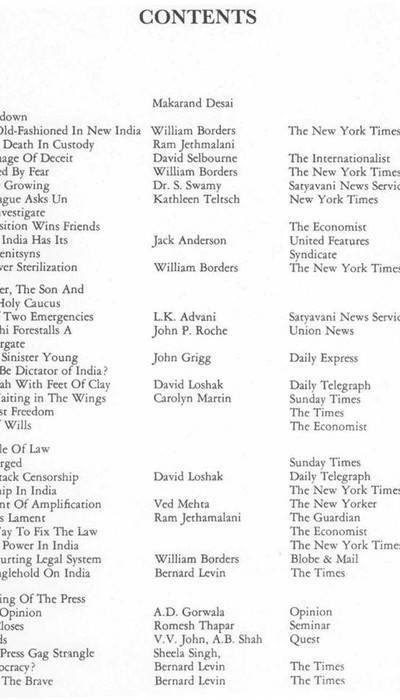 India, Indira Gandhi, Emergency 1975, India, Indira Gandhi, Emergency 1975, |
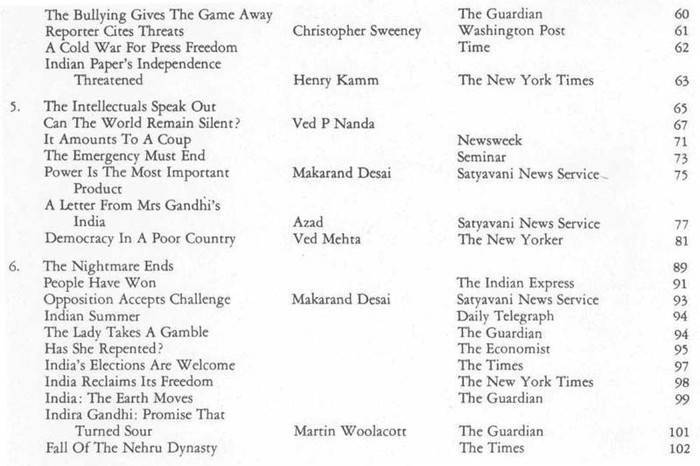 India, Indira Gandhi, Emergency 1975 |
‘News and underground literature from every possible struggle centre in India were arranged to be sent out. Friends of India affiliates around the world surveyed the world press and sent the press cuttings to our publication headquarters’ the book states. “From this collection emerged the fortnightly Satyavani. It was individually mailed, disguised as personal letters, business correspondence or trade literature to hundreds of innocuous addresses,” said Makarand as he boasted about the efficiency of the system.
The Impact And Legacy
‘For example, a dozen individual copies of Satyavani would reach Delhi from a dozen different centres—from Hong Kong or Nairobi or London or Ottawa. This never allowed the Indian censors to intercept the copies.
It is evidence of this system’s efficiency that Satyavani could be read in the various jails where thousands were behind bars.’ Satyavani’s credibility is said to have improved as the veracity of the news reported started being recognized. The smuggled magazine was instantly copied by various others in India as the government’s propaganda and lies were found to be unraveled by the magazine and foreign reports.
‘I hope that this compilation ‘The Smugglers of Truth’ will be a constant reminder of what can and did happen. Whenever we have doubts about freedom, democracy, and the rule of law, let us open this book at random and reinforce our faith in a free and democratic Bharat,’states Makarand’s closing lines in the preface of the book, an ironical reminder of how our amnesia has failed those who survived the Second Struggle for Independence while even LK Advani, Makarand’s fellow BJP member, believes that India could again face the Emergency as India’s civil liberties still remain vulnerable to such threats.
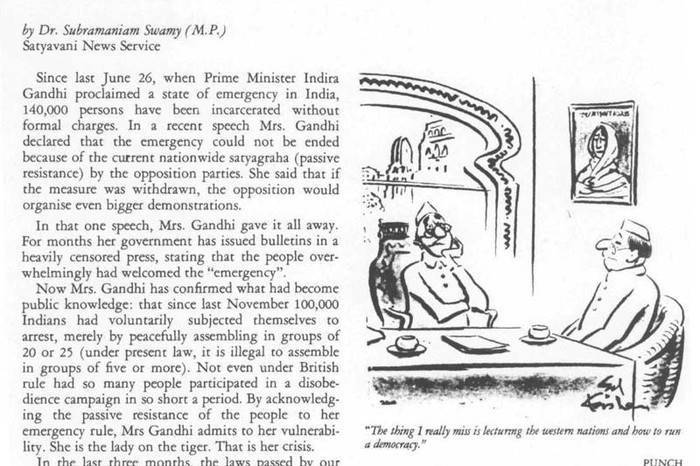 India, Emergency, Indira Gandhi, 1975, Press |
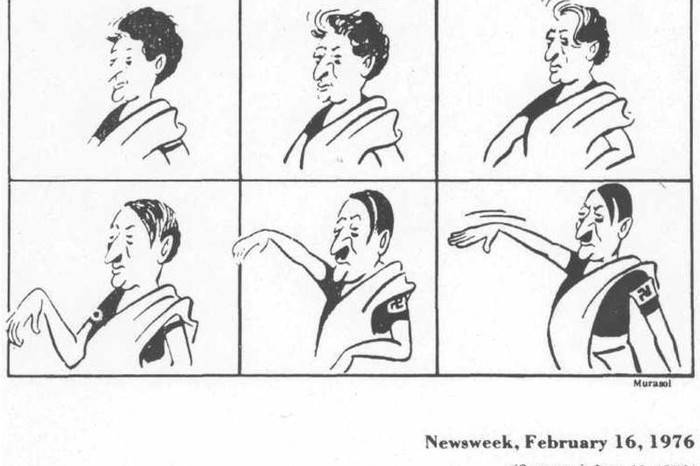 India, Indira Gandhi, Satyavani, Emergency 1975, Hitler |
 India, Indira Gandhi, Satyavani, Emergency 1975, Hitler |
References:
 Support Us
Support Us
Satyagraha was born from the heart of our land, with an undying aim to unveil the true essence of Bharat. It seeks to illuminate the hidden tales of our valiant freedom fighters and the rich chronicles that haven't yet sung their complete melody in the mainstream.
While platforms like NDTV and 'The Wire' effortlessly garner funds under the banner of safeguarding democracy, we at Satyagraha walk a different path. Our strength and resonance come from you. In this journey to weave a stronger Bharat, every little contribution amplifies our voice. Let's come together, contribute as you can, and champion the true spirit of our nation.
 |  |  |
| ICICI Bank of Satyaagrah | Razorpay Bank of Satyaagrah | PayPal Bank of Satyaagrah - For International Payments |
If all above doesn't work, then try the LINK below:
Please share the article on other platforms
DISCLAIMER: The author is solely responsible for the views expressed in this article. The author carries the responsibility for citing and/or licensing of images utilized within the text. The website also frequently uses non-commercial images for representational purposes only in line with the article. We are not responsible for the authenticity of such images. If some images have a copyright issue, we request the person/entity to contact us at This email address is being protected from spambots. You need JavaScript enabled to view it. and we will take the necessary actions to resolve the issue.
Related Articles
- How Political ambitions of the Congress has silenced contributions of uncountable freedom fighters
- Wikileaks and 5 lesser know facts of Indira Gandhi: Nuclear technology, corruption and foreign relations
- Golden time of Nehru dynasty, when assets of country like Indian Navy were used for Vacation and to 'pay respect' to Edwina Mountbatten's death
- Saam Daam Dand Bhed: How Indira and Sanjay Gandhi pulled off the Maruti scam
- How Communists betrayed India - 100 Years of Russian Revolution
- Can Communism and Democracy Coexist - 100 Years of Russian Revolution
- How Nehru had laid blue print of Indira Gandhi inheriting his PM post
- Biggest Secret Reveal - How ties between Indra Gandhi and KGB made India a puppet of USSR during the Cold War
- "PM Modi mentions the 1966 bombing of Mizoram": When Indira Gandhi had ordered the IAF to carry out an aerial attack in Aizawl and its aftereffects that still reverberate in India's history, capturing Mizoram's tumultuous journey through adversity
- How undisciplined Indira Gandhi when expelled from Congress Party by 'Syndicate', divided the party into two: 12 November 1969
- Indira Gandhi’s bahu published intimate photos of Jagjivan Ram’s son in her magazine: This 'Saas-Bahu ki Saajish' mothered India’s first major political sex scandal which cost Jagjivan his political career
- Three generations of Nehru-Gandhi dynasty has visited Babur’s tomb in Afghanistan: Did you know?
- Indira Gandhi’s assassins were martyrs says SGPC, pays homage and honours their family members: Punjab
- "The universe always balances the books": Congress leader Sajjan Kumar faces intensified legal scrutiny over the 1984 anti-Sikh riots, amidst a slew of charges, the spotlight centers on his alleged abetment in the Janakpuri and Vikaspuri incidents
- Was Indira Gandhi a Soviet Agent - 100 Years of Russian Revolution





















